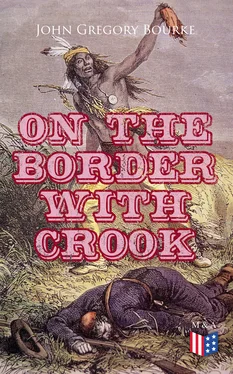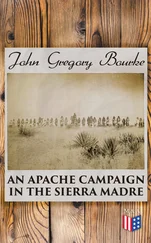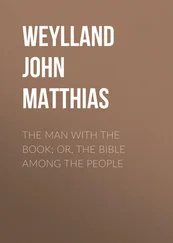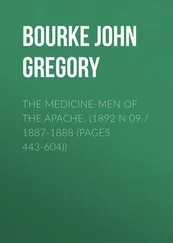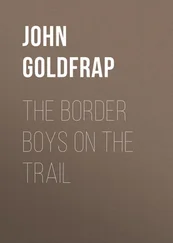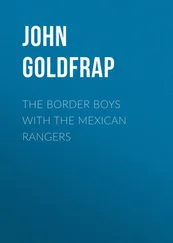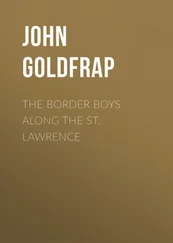On the 5th day of May, 1871, Lieutenant Howard B. Cushing, Third Cavalry, with several civilians and three soldiers, was killed by the Chiricahua Apaches, under their famous chief “Cocheis,” at the Bear Springs, in the Whetstone Mountains, about thirty-five miles from Tucson and about the same distance to the east of old Camp Crittenden. Cushing’s whole force numbered twenty-two men, the larger part of whom were led into an ambuscade in the cañon containing the spring. The fight was a desperate one, and fought with courage and great skill on both sides. Our forces were surrounded before a shot had been fired; and it was while Cushing was endeavoring to lead his men back that he received the wounds which killed him. Had it not been for the courage and good judgment displayed by Sergeant John Mott, who had seen a great amount of service against the Apaches, not one of the command would have escaped alive out of the cañon.
Mott was in command of the rear-guard, and, in coming up to the assistance of Lieutenant Cushing, detected the Apaches moving behind a low range of hills to gain Cushing’s rear. He sent word ahead, and that induced Lieutenant Cushing to fall back.
After Cushing dropped, the Apaches made a determined charge and came upon our men hand to hand. The little detachment could save only those horses and mules which were ridden at the moment the enemy made the attack, because the men who had dismounted to fight on foot were unable to remount, such was the impetuosity of the rush made by the Chiricahuas. There were enough animals to “ride and tie,” and Mott, by keeping up on the backbone of the hills running along the Barbacomori Valley, was enabled to reach Camp Crittenden without being surrounded or ambuscaded.
Inside of forty-eight hours there were three troops of cavalry en route to Crittenden, and in pursuit of the Apaches, but no good could be effected. Major William J. Ross, at that time in command of Camp Crittenden, was most energetic in getting word to the various military commands in the southern part of the country, as well as in extending every aid and kindness to the wounded brought in by Mott.
When the combined force had arrived at Bear Spring, there was to be seen every evidence of a most bloody struggle. The bodies of Lieutenant Cushing and comrades lay where they had fallen, stripped of clothing, which the Apaches always carried off from their victims. In all parts of the narrow little cañon were the carcasses of ponies and horses half-eaten by the coyotes and buzzards; broken saddles, saddle-bags, canteens with bullet-holes in them, pieces of harness and shreds of clothing scattered about, charred to a crisp in the flames which the savages had ignited in the grass to conceal their line of retreat.
Of how many Apaches had been killed, there was not the remotest suggestion to be obtained. That there had been a heavy loss among the Indians could be suspected from the signs of bodies having been dragged to certain points, and there, apparently, put on pony-back.
The Chiricahuas seemed to have ascended the cañon until they had attained the crest of the range in a fringe of pine timber; but no sooner did they pass over into the northern foot-hills than they broke in every direction, and did not re-unite until near our boundary line with Mexico, where their trail was struck and followed for several days by Major Gerald Russell of the Third Cavalry. They never halted until they had regained the depths of the Sierra Madre, their chosen haunt, and towards which Russell followed them so long as his broken-down animals could travel.
Of the distinguished services rendered to Arizona by Lieutenant Cushing, a book might well be written. It is not intended to disparage anybody when I say that he had performed herculean and more notable work, perhaps, than had been performed by any other officer of corresponding rank either before or since. Southern Arizona owed much to the gallant officers who wore out strength and freely risked life and limb in her defence—men of the stamp of Devin, C. C. Carr, Sanford, Gerald Russell, Winters, Harris, Almy, Carroll, McCleave, Kelly, and many others. They were all good men and true; but if there were any choice among them I am sure that the verdict, if left to those soldiers themselves, would be in favor of Cushing.
Standing on the summit of the Whetstone Range, which has no great height, one can see the places, or the hills overlooking them, where several other officers met their death at the hands of the same foe. To the west is Davidson’s Cañon, where the Apaches ambushed and killed Lieutenant Reid T. Stewart and Corporal Black; on the north, the cone of Trumbull overlooks the San Carlos Agency, where the brave Almy fell; to the northwest are the Tortolita hills, near which Miller and Tappan were killed in ambuscade, as already narrated; and to the east are the Chiricahua Mountains, in whose bosom rests Fort Bowie with its grewsome graveyard filled with such inscriptions as “Killed by the Apaches,” “Met his death at the hands of the Apaches,” “Died of wounds inflicted by Apache Indians,” and at times “Tortured and killed by Apaches.” One visit to that cemetery was warranted to furnish the most callous with nightmares for a month.
Конец ознакомительного фрагмента.
Текст предоставлен ООО «ЛитРес».
Прочитайте эту книгу целиком, купив полную легальную версию на ЛитРес.
Безопасно оплатить книгу можно банковской картой Visa, MasterCard, Maestro, со счета мобильного телефона, с платежного терминала, в салоне МТС или Связной, через PayPal, WebMoney, Яндекс.Деньги, QIWI Кошелек, бонусными картами или другим удобным Вам способом.
